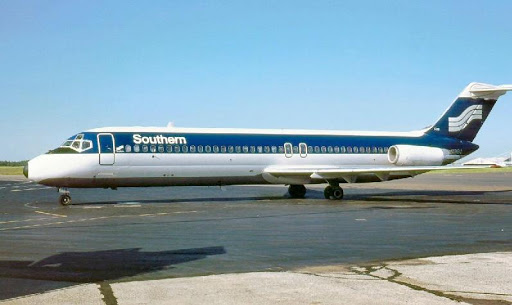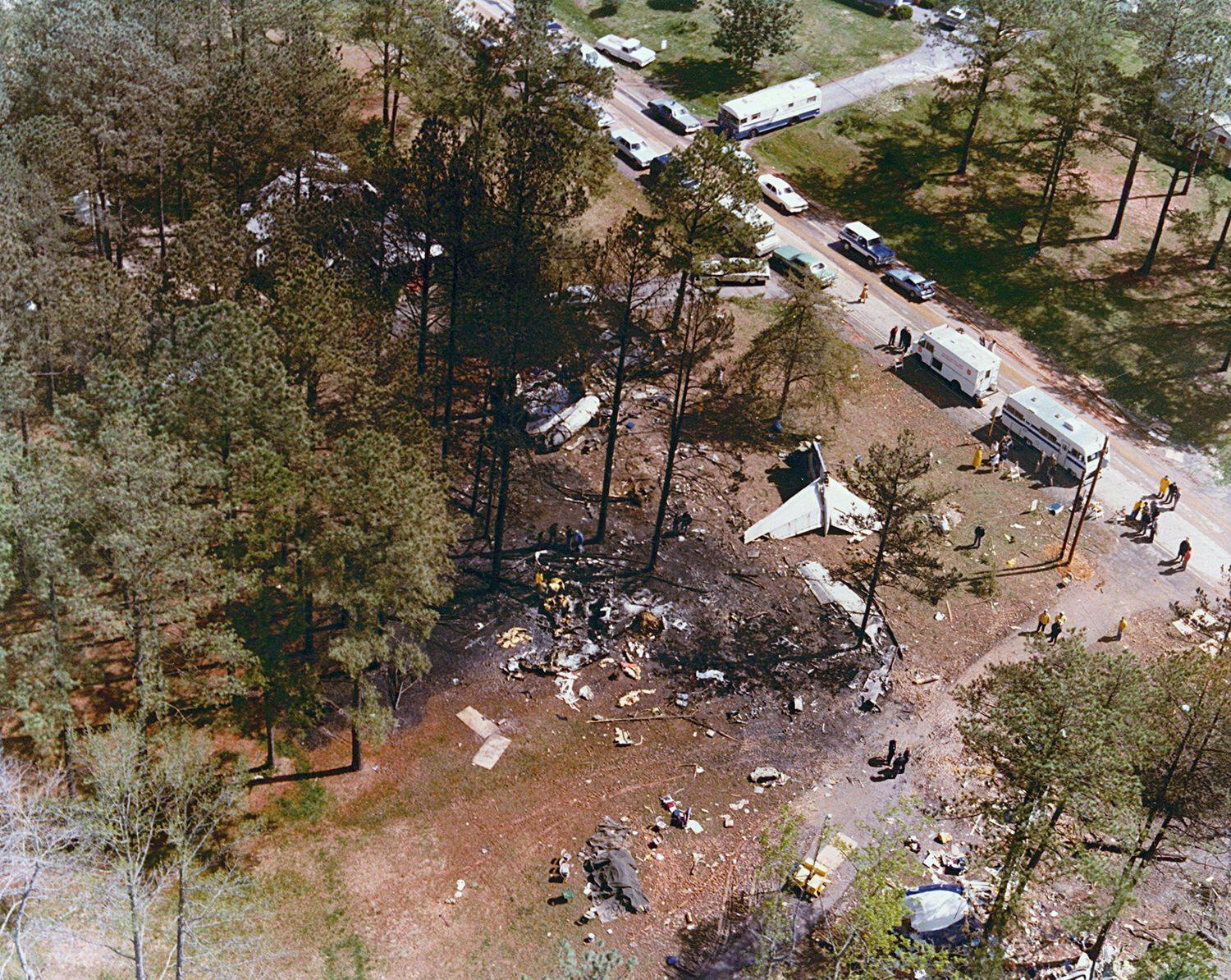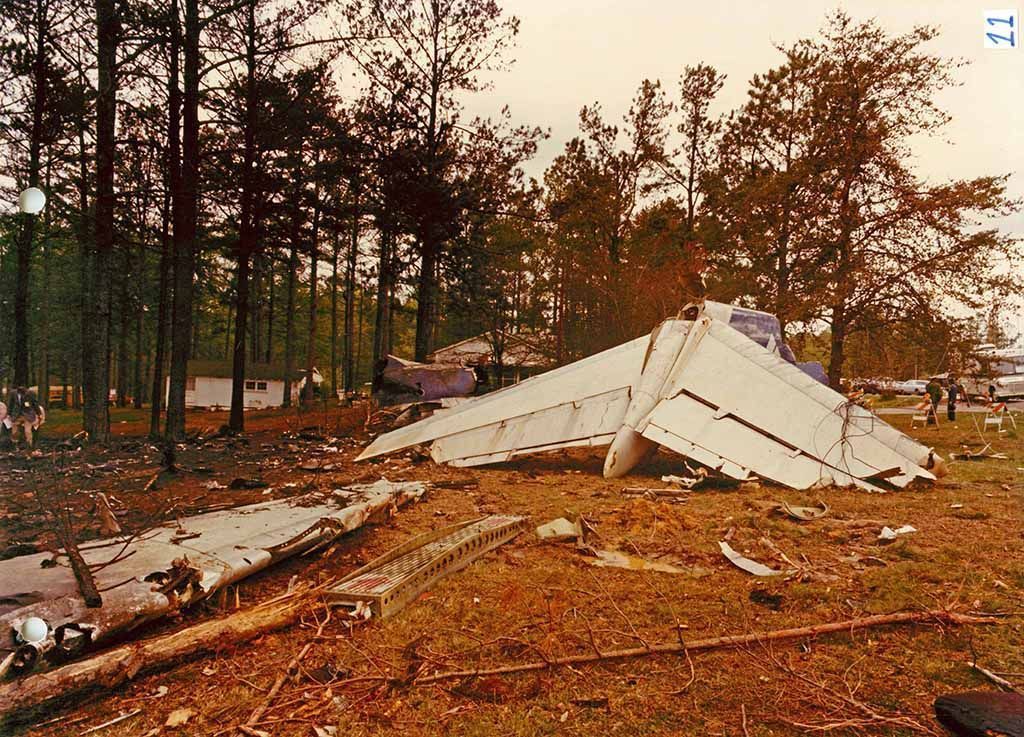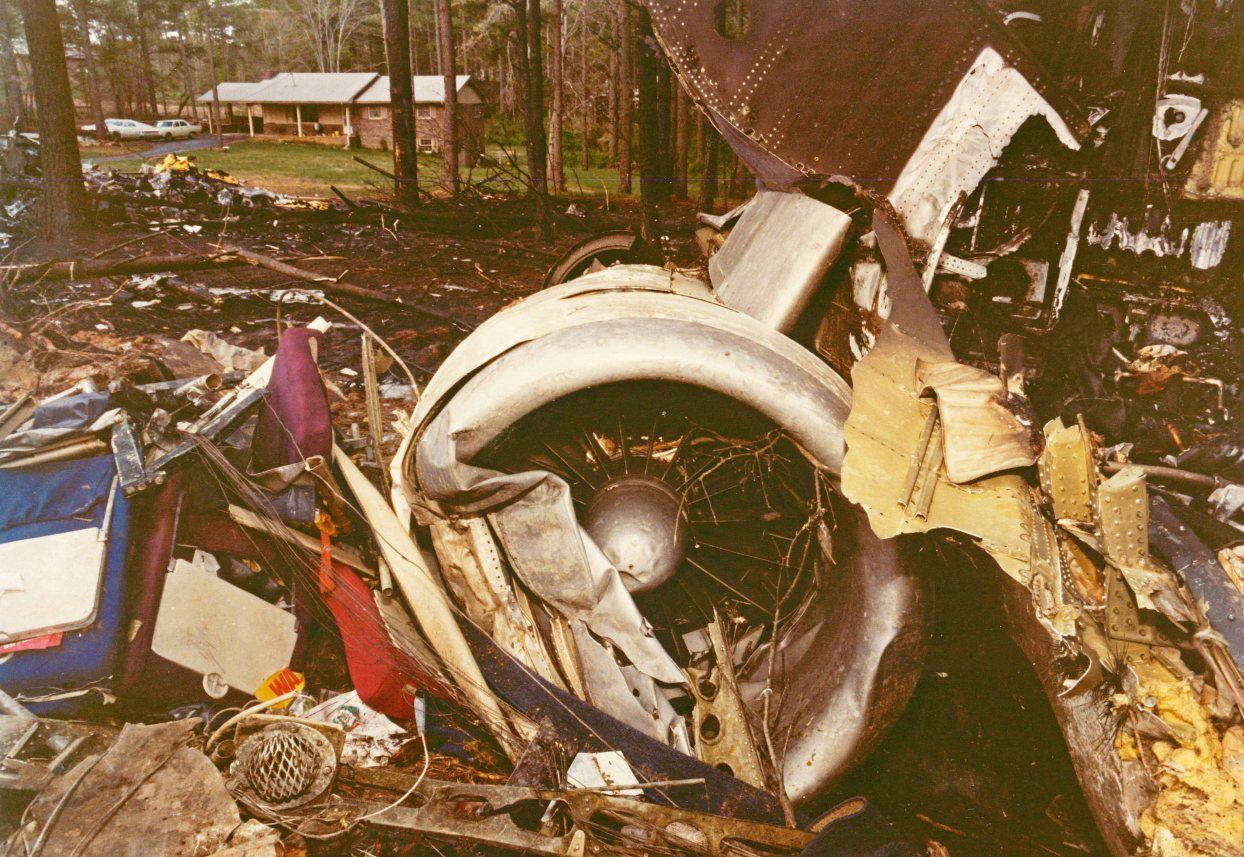4 Apr 1977 - Southern Airways 242
Southern Airways Flight 242 was a DC-9-31 jet, registered N1335U, that executed a forced landing on a highway in New Hope, Paulding County, Georgia, United States after suffering hail damage and losing thrust on both engines in a severe thunderstorm on April 4, 1977.
At the time of the accident, the Southern Airways aircraft was flying from Huntsville, Alabama to Atlanta, Georgia. Sixty-three people on the aircraft (including the flight crew) and nine people on the ground died; twenty passengers survived, as well as the two flight attendants; one passenger who initially survived died around one month later.

The flight crew, consisting of captain Bill McKenzie and co-pilot Lyman Keele, was advised of the presence of embedded thunderstorms and possible tornadoes along their general route prior to their departure from Huntsville, but was not subsequently updated of the fact that the cells formed into a squall line. The flight crew had flown through that same area from Atlanta earlier in the day, and encountered only mild turbulence and light rain during those flights.
The weather system had apparently intensified in the meantime. The peak convective activity was later shown on ground radar to be near Rome, Georgia, to which the flight was cleared to proceed by Air Traffic Control. The crew attempted to pick out a path through the cells depicted on their onboard weather radar display, but were apparently misled by the radar's attenuation effect and proceeded toward what they perceived as a low intensity area, which in fact was the peak convective activity point, attenuated by rain.
As the flight descended from its cruise altitude of 17,000 feet to 14,000 feet near Rome VOR, it apparently entered a thunderstorm cell and encountered a massive amount of water and hail. The hail was intense enough to break the aircraft's windshield, and due to ingestion of the water and hail combination, both engines were damaged and underwent flameout.
The crew attempted unsuccessfully to restart the engines, gliding down unpowered while simultaneously trying to find an emergency landing field within range. Air Traffic Control suggested Dobbins Air Force Base, about 20 miles east, as a possible landing site, but it was beyond reach. Another option, Cartersville Airport, a general aviation airport about 15 miles north with a much shorter runway intended for light aircraft was considered, but it was behind the aircraft and now out of reach. As the aircraft ran out of altitude and options, gliding with a broken windshield and no engine power, the crew made visual contact with the ground and spotted a straight section of a rural highway below. They executed an unpowered forced landing on that road, but during the rollout the aircraft collided with a gas station/grocery store and other structures. The flight crew and 60 passengers were killed during the forced landing due to impact forces and fire, but 19 of the passengers ultimately survived, as well as both flight attendants. Eight people on the ground died. One passenger initially survived the crash but died on June 5, 1977. A seriously injured person on the ground died around one month later. The NTSB defined the injuries for them as serious, as the agency defined a fatal injury as one that occurs within 7 days of the accident.

Download the full NTSB report
Transcript of the Cockpit Voice Recorder (CVR)
In the following transcript of communications during this scenario, conversations conducted inside the cockpit are italicized; those between the aircraft and the ground are not. Capt is Flight 242’s captain, FO is the first officer, S242 is radio transmissions from the flight, AC is Atlanta Center, AA is Atlanta Approach, and CAM denotes information from the airplane’s cockpit area mic. Dialog in italics is crew conversation recorded on the DC–9’s cockpit voice recorder.
4:03:48 Capt: "Looks heavy, nothing’s going through that."
4:03:54 Capt: "See that?"
4:03:56 FO: "That’s a hole , isn’t it?"
4:03:57 Capt: "It’s not showing a hole; see it?"
4:04:05 CAM: (Sound of rain)
4:04:08 FO: "Do you want to go around that right now?"
4:04:19 Capt: "Hand fly at about two eighty-five knots."
FO: "Two eight five."
4:04:30 CAM: (Sound of hail and rain)
4:04:53 S242: "Southern Two-Forty-Two, we’re slowing it up here a little bit."
4:04:53 AC: "Two-Forty-Two, roger."
4:05:53 FO: "Which way do we go, cross here or go out—I don’t know how we get through there, Bill."
Capt: "I know you’re just gonna have to go out…."
FO: "Yeah, right across that band."
4:06:01 Capt: "All clear left approximately right now; I think we can cut across there now."
4:06:12 FO: "All right, here we go."
4:06:25 FO: "We’re picking up some ice, Bill."
4:06:29 Capt: "We are above 10 degrees."
FO: "Right at 10."
Capt: "Yeah."
4:06:30 AC (to TWA 584): "I show the weather up northwest of that position north of Rome, just on the edge of it—I tell you what, maintain one five thousand."
4:06:38 TWA 584: "Maintain one five thousand; we paint pretty good weather one or two o’clock."
4:06:41 FO: "He’s got to be right through that hole about now."
4:06:42 AC: "Southern Two-Forty-Two descend and maintain one four thousand at this time."
4:06:46 Capt: "Who’s that?"
4:06:48 FO: "TWA."
AC: "Southern Two-Forty-Two, descend and maintain one four thousand."
4:06:53 S242: "Two-Forty-Two down to fourteen."
4:06:55 AC: "Affirmative."
CAM: (Heavy hail or rain sound starts and continues until power interruption.)
4:07:00 AC: "Southern Two-Forty-Two, Atlanta altimeter two-niner-five-six, and cross 40 miles northwest of Atlanta two-five-zero knots."
CAM: (Sound similar to electrical disturbance)
4:07:57 CAM: (Power interruption for 36 seconds)
4:08:33 CAM: (Power restored)
CAM: (Sound of rain continues for 40 seconds)
4:08:34 AC: "Southern Two-Forty-Two, Atlanta."
4:08:37 FO: "Got it, got it back, Bill; got it back, got it back [probably referring to the engines]."
4:08:42 S242: "Uh, Two-Forty-Two, stand by."
4:08:46 AC: "Say again."
4:08:48 S242: "Stand by."
4:08:49 AC: "Roger, maintain one five thousand if you understand me; maintain one five thousand, Southern Two-Forty-Two."
4:08:55 S242: "We’re trying to get it up there."
4:08:57 AC: "Roger."
4:09:15 S242: "Okay, uh, Two-Forty-Two, uh, we just got our windshield busted and, uh, we’ll try to get it back up to fifteen, we’re fourteen."
4:09:24 FO: "Fifteen thousand."
4:09:25 AC: "Southern Two-Forty-Two, you say you’re at fourteen now?"
4:09:27 S242: "Yeah, uh, couldn’t help it."
4:09:30 AC: "That’s OK, uh, are you squawking five-six-two-three?"
4:09:36 FO: "Left engine won’t spool."
4:09:37 S242: "Our left engine just cut out."
4:09:42 AC: "Southern Two-Forty-Two roger, and, uh, lost your transponder, squawk five-six-two-three."
4:09:43 FO: "I am squawking five-six-two-three, tell him I’m level fourteen."
4:09:49 S242: "Five-six-two-three, we’re squawking."
4:09:53 AC: "Say you lost an engine and, uh, busted a windshield?"
4:09:56 S242: "Yes sir."
4:09:59 Capt: "Autopilot’s off."
FO: "I’ve got it; I’ll hand-fly it."
4:10:00 AC: "Southern Two-Forty-Two, you can descend and maintain one three thousand now, that’ll get you down a little lower."
4:10:04 FO: "My (deleted), the other engine’s going, too (deleted)"
4:10:05 S242: "Got the other engine going, too."
4:10:08 AC: "Southern Two-Forty-Two, say again."
4:10:10 S242: "Stand by—we lost both engines."
4:10:14 FO: "All right, Bill, get us a vector to a clear area."
4:10:16 S242: "Get us a vector to a clear area, Atlanta."
4:10:20 AC: "Uh, continue present southeastern bound heading; TWA’s off to your left about 14 miles at fourteen thousand and says he’s in the clear."
4:10:25 S242: "OK."
4:10:27 S242: "Want us to turn left?"
4:10:30 AC: "Southern Two-Forty-Two, contact approach control, one two six point nine, and they’ll try to get you straight into Dobbins."
4:10:35 S242: "One two—."
4:10:36 FO: "Give me—I’m familiar with Dobbins; tell them to give me a vector to Dobbins if they’re clear.
4:10:38 S242: "Give me, uh, vector to Dobbins if they’re clear."
4:10:41 AC: "Southern Two-Forty-Two, one twenty-six point nine, they’ll give you a vector to Dobbins."
4:10:45 S242: "Twenty-six nine, OK."
4:10:50 FO: "Ignition override, it’s gotta work by (deleted)."
4:10:56 CAM: [Power interruption for 2 minutes, 4 seconds]
4:13:00 CAM: [Power restored]
4:13:03 Capt: "There we go."
FO: "Get us a vector to Dobbins."
4:13:04 S242: "Uh, Atlanta, you read Southern Two-Forty-Two?"
4:13:08 AA: "Southern Two-Forty-Two, Atlanta approach control; uh, go ahead.
4:13:11 S242: "Uh, we’ve lost both engines—how about giving us a vector to the nearest place. We’re at seven thousand feet.
4:13:17 AA: "Southern Two-Forty-Two, roger, turn right heading one zero zero, will be vectors to Dobbins for a straight-in approach Runway One-One, altimeter two niner five two, your position is 15, correction 20 miles west of Dobbins at this time."
4:13:18 FO: "What’s Dobbins’ weather, Bill? How far is it? How far is it?"
4:13:31 S242: "Okay, uh, one-forty heading and 20 miles."
4:13:35 AA: "Ah, make a heading of one-two-zero, Southern Two-Forty-Two, right turn to one-two-zero."
4:13:40 S242: "Okay, right turn to one-two-zero and, uh, you got us our squawk, haven’t you, on emergency?"
FO: "Declare an emergency, Bill."
4:13:45 AA: "Uh, I’m not receiving it. But radar contact; your position is 20 miles west of Dobbins."
4:14:03 FO: "Get those engines (deleted)."
4:14:24 S242: "All right, listen, we’ve lost both engines, and, uh, I can’t, uh, tell you the implications of this—we, uh, only got two engines and how far is Dobbins now?"
4:14:34 AA: "Southern, uh, Two-Forty-Two, uh, 19 miles."
4:14:40 S242: "OK, we’re out of, uh, fifty-eight hundred, 200 knots."
4:14:44 FO: "What’s our speed? Let’s see, what’s our weight, Bill? Get me a bug speed."
4:14:45 AA: "Southern Two-Forty-Two, do you have one engine running now?"
4:14:47 FO: "No."
4:14:48 S242: "Negative, no engines."
4:14:50 AA: "Roger."
4:14:59 Capt: "One twenty six." [This probably refers to the final approach speed.]
FO: "One twenty six."
4:15:04 Capt: "Just don’t stall this thing out."
FO: "No, I won’t."
Capt: "Get your wing flaps."
CAM: [Sound of lever movement.]
4:15:11 FO: "Got it, got hydraulics so we got…."
Capt: "We got hydraulics."
4:15:17 FO: "What’s the Dobbins weather?
4:15:18 S242: "What’s your Dobbins weather?"
4:15:22 AA: "Stand by."
4:15:25 FO: "Get Dobbins on the approach plate."
4:15:42 Capt: "I can’t find Dobbins. Tell me where’s it at? Atlanta?"
FO: "Yes."
4:15:46 AA: "Southern Two-Forty-Two, Dobbins weather is two thousand scattered, estimated ceiling three thousand broken, seven thousand overcast, visibility seven miles."
4:15:57 S242: "OK, we’re down to forty-six hundred now."
4:15:59 FO: "How far is it? How far is it?"
4:16:00 AA: "Roger, and you’re approximately, uh, 17 miles west of Dobbins at this time."
4:16:05 S242: "I don’t know whether we can make that or not."
4:16:07 AA: "Roger."
4:16:11 FO: "Ah, ask him if there is anything between here and Dobbins?
Capt: "What?"
FO: "Ask him if there is anything between here and Dobbins."
4:16:25 S242: "Uh, is there any airport between our position and Dobbins?"
4:16:29 AA: "Southern Two-Forty-Two, uh, no sir, uh, closest airport is Dobbins."
4:16:34 S242: "I doubt we’re going to make it, but we’re trying everything to get something started."
4:16:38 AA: "Roger, well, there is Cartersville; you’re approximately 10 miles south of Cartersville, 15 miles west of Dobbins."
4:16:44 FO: "We’ll take a vector to that. Yes, we’ll have to go there."
4:16:45 S242: "Can you give us a vector to Cartersville?"
4:16:47 AA: "All right, turn left, heading of three-six-zero be directly, uh, direct vector to Cartersville."
4:16:52 S242: "Three six zero, roger."
FO: "What runway? What’s the heading on the runway?"
4:16:53 S242: "What’s the runway heading?"
4:16:58 AA: "Stand by."
4:16:59 S242: "And how long is it?"
4:17:00 AA: "Stand by."
4:17:08 Capt: "Like we are, I’m picking out a clear field."
4:17:12 FO: "Bill, you’ve got to find me a highway."
Capt: "Let’s get the next clear open field."
FO: "No (deleted)."
4:17:35 Capt: "See a highway over—no cars."
FO: "Right there, is that straight?"
4:17:39 Capt: "No."
4:17:44 AA: "Southern Two-Forty-Two, the runway configuration…"
FO: "We’ll have to take it."
4:17:55 AA: "…at Cartersville is, uh, three six zero and running north and south and the elevation is seven hundred fifty-six feet and, uh, trying to get the length of now—it’s three thousand two hundred feet long."
4:17:58 CAM: [Beep on gear horn.]
CAM: [Gear horn steady for 4 seconds.]
4:18:02 S242: "Uh, we’re putting it on the highway, we’re down to nothing."
4:18:07 FO: "Flaps."
Capt: "They’re at fifty."
FO: "Oh (deleted), Bill, I hope we can do it."
4:18:14 FO: "I’ve got it, I got it."
4:18:15 FO: "I’m going to land right over that guy."
4:18:20 Capt: "There’s a car ahead."
4:18:25 FO: "I got it Bill, I’ve got it now, I got it.
Capt: "OK."
4:18:30 Capt: "Don’t stall it."
FO: "I gotta bug."
4:18:31 FO: "We’re going to do it right here."
4:18:34 FO: "I got it."
4:18:36 CAM: [Sound of breakup.]
4:18:43 End of tape.

Flight 242 crashed on a road and slid for roughly 1,830 feet before colliding with a convenience store/gas station. Sixty-two people on board the aircraft died, including the cockpit crew. Eight people on the ground also perished. There were 21 passengers who survived, along with the flight attendants.
According to one of the surviving passengers who held a commercial pilot certificate, the flight was routine until the aircraft encountered severe turbulence, followed by very heavy precipitation, a lightning strike on the left wing tip, and hail. The hail increased in size and intensity, then the right engine quit, and the left engine quit shortly thereafter. Coincident with the turbulence, the power was reduced on the engines. The passenger estimated that the turbulence lasted one to two minutes, the heavy rain continued for 45 seconds, and the hail for about the same amount of time. The engines quit just after the hail stopped. Shortly after that the auxiliary power unit (APU) was started. The two flight attendants had similar recollections.
According to the post-accident analysis by the NWS, the storm system was one of the worst on record, spawning 20 tornadoes and 30 severe thunderstorms. It was clearly not business as usual. According to the radar plot, Flight 242 went through the line very close to the largest thunderstorm cell. Level Five is categorized as an intense thunderstorm with rainfall rate of 2 to 5 inches per hour, and Level Six is considered extreme.
Never before had an air carrier aircraft had both engines snuffed out by a thunderstorm. The probability was considered so remote that the aircraft flight manual had no guidance on what to do when a DC–9 becomes a glider. The maximum gliding distance from 14,000 feet was estimated at 34 miles. The crew coaxed about 32.5 miles out of the aircraft, which is a remarkable performance for an untrained maneuver.
In a masterful understatement the NTSB concluded that "after complete failure of the engines, an accident was most probably inevitable…." The board surmised that shortly after the loss of the engines, the flight may have entered visual conditions. The pilots, busy with attempted restart of both engines and the APU to restore electrical power, chose to stay visual, which may account for the 180-degree turn westbound.
The findings were that the flight penetrated a severe thunderstorm and the ingestion of intense rain and hail caused both engines to fail. The engines suffered internal damage and could not be restarted. The crew had no information on the storms west of Rome, and the captain initially decided, based on his airborne weather radar returns, that the storms were too severe to penetrate. For some reason or because of misinterpretation of the radar display, he changed his mind.
The Board determined the probable cause to be the "total and unique loss of thrust from both engines while the aircraft was penetrating an area of severe weather." Board member Francis McAdams dissented, stating that the majority belief "was merely a statement of what happened rather than an explanation of why." His determination of probable cause is more likely much closer to the mark. "This accident involves the captain’s critical decision to penetrate rather than avoid a known area of severe weather…. It is obvious that the captain flew a route or directed the FO to fly a route into an area which aircraft should not have entered. Southern Airways, and all air carriers, prohibit flying into convective storms because these types of storms are known to be serious hazards. The primary hazard relates to forces in these storms which can destroy an aircraft structurally; however, other hazards exist which are not well defined…. The loss of thrust…might have been unusual…but should not be considered entirely unexpected, given the multiple hazards associated with flight into severe convective storms."
With this well-researched accident in mind, let’s review how the pilot in a GA aircraft also misread the power of the force. On August 30, 1996, a Cessna 421B with a 3,000-hour instrument-rated private pilot started a trip from New Mexico to Oklahoma. At 4:15 p.m. the pilot called flight service to get a briefing and file an IFR flight plan. He was advised of building thunderstorm activity from Raton, New Mexico, to Garden City, Kansas. There were scattered thunderstorms in the Oklahoma panhandle, but there were no Sigmets.
The flight departed and checked in with Albuquerque Center. It was cleared to Flight Level 210, and shortly afterward the pilot asked for FL190. That was approved with no unusual communications or comments regarding the weather. At 6:23 p.m. Albuquerque lost radar contact with the 421. At 5:55 a convective Sigmet was issued for isolated severe storms with 20-mile diameters and tops to 45,000 feet, but this information was never passed to the pilot.
In his written report of the accident, the pilot stated that there were "some clouds" approximately 50 to 60 miles ahead. "I turned on the on-board radar scope and could see precipitation to the left and right of our path. However, the center area, probably 15 to 20 miles wide, was clear on the scope. This was the area that I planned to go through the clouds. They did not appear to be dark thunderstorms, only clouds like I had flown through many times before.
"Before we reached those clouds, about 10 miles before, is when we encountered hail. It first appeared as rain, and then within one minute of the first encounter, a large piece of ice broke through the left windshield."
The right-seat passenger was a private pilot who was neither instrument- nor multiengine-rated. He noted that the on-board weather radar was on but did not indicate strong storms directly in their path. "It showed rain on both sides but just a small ring of rain in front." After the windshield broke, the left-seat pilot appeared dazed and put his head in his lap. The passenger took over the controls and attempted to keep the wings level. He stated that he "never felt dizzy or lightheaded."
The next thing the right-seat passenger remembered was the back-seat passenger waking him up on the ground. The 421 had crashed in an open field and all the occupants survived. A call to 911 on a cellular telephone brought help about four hours later because of the remoteness of the site.
Both of these accidents remind us that one of the primary tools that we have in order to avoid thunderstorms—weather radar—is fallible. Or perhaps it would be more correct to say that interpretation must be done carefully. Situations that look flyable, based on prior experience, may not be. The Southern Airways captain failed to reckon with the explosive growth of what had been a benign line of weather two hours earlier and didn’t take full advantage of the resources available to him. The Cessna 421 pilot took what appeared to be a reasonable course of action. He learned about radar attenuation and that hail does not show up well on radar. Mountain-state storms frequently have hail and require a wide berth.

In discussion of these accidents with some very experienced pilots, they all had the same admonishment—thunderstorms, by nature, are unpredictable and a healthy distance is good insurance. Some of the very best flying hours are those spent avoiding convective activity.
Squeeze play: History repeats itself
On May 7, 1998, a DC–9 enroute from Atlanta to Chicago encountered turbulence and hail while climbing through 20,000 feet. The aircraft was in instrument conditions and received substantial damage. A flight attendant was seriously injured. The flight crew was deviating around weather and was following another aircraft that went through the same area between two cells.
The hail lasted about five seconds, with moderate turbulence for 30 seconds. Three front windshield outer panels were shattered, with impact damage to the wing leading edge, horizontal stabilizer, and engine inlet cowls. Both engines were also damaged as the aircraft radome separated from the aircraft and was partially ingested by the engines. Both airspeed indicators also became inoperative; ATC provided speed readouts every 10 to 15 seconds. The flight made an emergency landing in Chattanooga, Tennessee. A major investigation is in progress.

